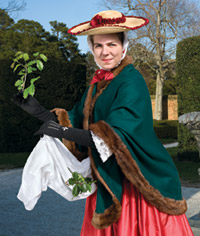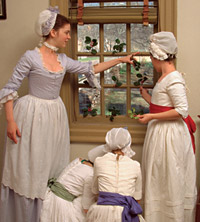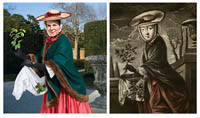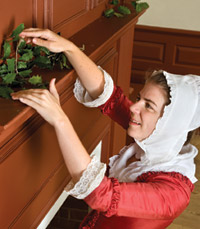With Boughs of Holly
by Mary Miley Theobald
photos by Dave Doody

Carrying holly for seasonal decorations, Amy Griffin re-creates the pose in the eighteenth-century engraving December seen in Christmas in Prints.

Grace McArthur, Caroline Hollis, Suzanna Winder, and Amy Player, left to right, decorate windowpanes in the Geddy House with sprigs of holly for Christmas.
From Peasant Hut to royal palace, Europeans have for centuries decorated their homes and churches with greenery at Christmas. The tradition antedates the Christian era. Pagan societies like the Romans, the Celts, and the Norse observed Midwinter, the shortest day of the year, by decorating with cuttings of holly, ivy, bay, fir, rosemary, laurel, boxwood, mistletoe—any plant that remained green when woodlands and fields turned brown and bare. Holly, with its bright red berries and shiny green leaves, was perhaps the favorite ornamental.
For the Romans, holly was sacred to Saturn, the god of agriculture, whose late-December holiday, Saturnalia, provided the occasion for a week of raucous revelry. The Druids believed holly repelled evil spirits and protected people from witches and mad dogs, a superstition that persisted throughout the medieval period and caused many to keep holly in their homes or wear it in their clothing as a charm against witchcraft. In Celtic mythology, the Holly King fought the Oak King twice every year: the Holly King always won the battle at midsummer, ushering in shorter, colder days and causing the leaves to fall; the Oak King won at midwinter, bringing longer days, budding trees, and green fields.
Early Christian leaders tried without success to stamp out these pagan rituals and decorating customs. The more pragmatic among the clergy decided to convert the holly tree to Christianity by attributing Christian symbolism to its prickly leaves—the crown of thorns—while its crimson berries became the drops of blood on Christ’s brow. Its capacity to remain green all year long became a metaphor for eternal life after death. In English, the holly tree was now the holy tree, courtesy of the legend that the cross had been fashioned out of holly wood.
Holly is decorative in another way—its wood is hard, close grained, and, when the tree is cut during winter, almost white. These features make it ideal for furniture makers to use for inlay. The wood is also good for making musical instruments and piano keys. American holly, plentiful along the Eastern Seaboard, can grow as tall as forty or fifty feet, but few have trunks thick enough to yield more than small pieces of wood. Of 300 species of holly, about fifteen are native to North America. The most common of these, Ilex opaca, is known as American holly. Its poisonous red berries are not technically berries at all, but drupes—like olives, cherries, and peaches, the fruit has stones. Holly trees come in male and female; only the female have berries.
Ever since Christmas carols began in the fifteenth century, holly has figured prominently in their lyrics. One early song begins, “Here comes holly, that is so great.” Another of the same period goes, “Holly and Ivy, Box and Bay, Put in the Church on Christmas Day.” The well-known medieval carol that tells the story of the masculine holly and the feminine ivy says that
Of all the trees that are in the wood, The holly bears the crown.
And the ever-popular “Deck the Halls with Boughs of Holly” has been sung since the Renaissance. In old England, more than the halls were decked with holly boughs. In some towns, so were the streets. A half-century before Columbus brought news of a New World across the sea, Englishmen were erecting upright timbers called standards in the streets and adorning them with “whatsoever the season of the yeere aforded to be greene.” But for most Englishmen, and most who immigrated to the colonies, Christmas decorations meant indoor greenery.
Though no written sources describing colonial Virginia Christmas decorations have been discovered, historians have concluded that the usual English traditions continued in the colonies. Virginians considered themselves English in every sense of the word, clinging to Old World traditions while trying just as hard to keep up with the latest London fashions. Evidence of colonial-era decorating has to be sought in pictorial representation, such as prints and paintings, and in English practices of that era. Sometimes poems and carols provide clues, such as the Christmas poem in an almanac of 1695 that begins,
With holly and ivy so green and so gay,
We deck up our houses as fresh as the day.
English prints of the eighteenth century picture holly arranged in pretty vases, stuffed into crude pots, or stuck between the wooden muntins and the windowpanes. Decorating impulses did not stop with houses and churches; taverns and kitchens had their share of greenery as well, as prints and poems confirm:
From every hedge is pluck’d by eager hands
The holy-branch with prickly leaves replete,
And fraught with berries of a crimson hue;
Which, torn asunder from its parent trunk,
Is straight way taken to the neighboring towns;
Where windows, mantels, candlesticks,
and shelves,
Quarts, pints, decanters, pipkins, basons, jugs,
And other articles of household ware,
The verdant garb confess.
Judging from such sources, it seems safe to say that colonial Virginians decorated for Christmas a little, a lot, or not at all, according to individual whim. The person doing the decorating was, by custom, the woman of the house. References linking women to Christmas decorations go back at least as far as the 1500s, when, in one English poem, women were urged to decorate their houses for the holiday: “Get Ivye and hull, woman deck up thyne house.” By “hull” was meant holly. When to remove these decorations was subject to disagreement. Some Englishmen thought it unlucky to leave holly up after Twelfth Night, which falls January 6. “When Christmas is done, kepe not Christmas time still,” said a writer in 1557. Others believed the branches should be saved until the next winter to protect the household against lightning and to bring good luck in the new year.
By the 1800s, holly was known as “the prince of evergreens.” It was everywhere, its prickly sprigs wedged behind picture frames and clocks, twisted around the chains of chandeliers, arranged in vases, fastened to the tops of draperies, stuck into holiday dishes as a garnish, and pinned into women’s hair. A clever young lady might make up a pyramid of holly sprigs stuck into moss for the dining-room table. Baskets of holly sat on tables; banks of holly boughs were arranged behind vases of holly on fireplace mantels. Holly wreaths were hung indoors in the windows. Some of Virginia’s earliest Christmas trees were holly. Alice West Allen, who was eleven when she attended a Christmas party in Richmond in 1864, wrote:
A dear friend of my mother’s found that we were to spend Christmas in the city, so she invited us to a Christmas tree given to President Davis’s children. The tree was a lovely holly laden with homemade candles and dolls made out of hickory nuts and Canton flannel. . . . I have never seen anything that looked so pretty to me.
Not until the early twentieth century did magazines and decorating guides begin to encourage women to adorn the outside of the house as well as the inside with wreaths of holly or other evergreen. The popularity of the custom grew quickly, no doubt in part because the hardy cuttings stay green and fresh looking for a long time. After the bishop of Aberdeen, Scotland, spent the Christmas of 1926 in Virginia, he wrote, “In every window hangs a holly wreath and a holly wreath on every door.” A Richmond woman recalled those years:
The days before Christmas were spent in cutting cedar pine boughs and holly for decoration. . . . All the windows had holly wreaths, and the pictures had sprigs of holly. . . . The tying up of parcels with holly patterned papers tied with red ribbons and labeled was all important.
Holly wreaths were among the earliest Christmas decorations used at Colonial Williamsburg. When the restoration project funded by John D. Rockefeller Jr. opened to the public in 1934, there were no decorations at all on the exhibition buildings at Christmas. No one had anticipated guests during the holidays. When guests did come—and they came in great numbers—the subject of appropriate Christmas decorations was raised. The next Christmas, plain wreaths made of holly and other native evergreens were hung on the doors of some buildings, followed the year after by the fruit-bedecked versions that have epitomized the Williamsburg Christmas since.

Web Extra: Click image to compare with 18th-century engraving "December"
seen in "Christmas in Prints" in Autumn 2008 Journal.

